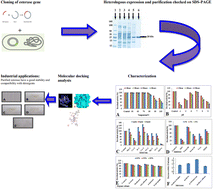Heterologous expression, molecular studies and biochemical characterization of a novel alkaline esterase gene from Bacillus thuringiensis for detergent industry
Abstract
Present study was aimed to clone and express the esterase encoding gene from Bacillus thuringiensis in E. coli BL21. Purification of recombinant esterase enzyme was achieved up to 48.6 purification folds by ion exchange chromatography with specific activity of 126.36 U mg−1. Molecular weight of esterase enzyme was 29 kDa as measured by SDS-PAGE. Purified esterase enzyme showed stability up to 90% at 90 °C and remained stable in a wide pH range (8–11). Molecular docking strengthens the experimental results by showing the higher binding energy with p-NP-butyrate. Enzyme activity was found to be reduced by EDTA but enhanced in the presence of other metal ions. Enzyme activity was reduced with 1% SDS, PMSF, and urea but organic solvents did not show considerable impact on it even at higher concentrations. Purified recombinant esterase was also found to be compatible with commercial laundry detergents and showed very good stability (up to 90%). All these properties proved the esterase enzyme from B. thuringensis a significant addition in detergent industry.



 Please wait while we load your content...
Please wait while we load your content...